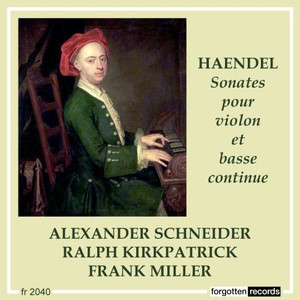
George Frideric Handel (1685-1759)
Sonatas for Violin and Basso Continuo
Sonata in A, HWV 361
Sonata in G minor, HWV 368
Sonata in F, HWV 370
Sonata in D, HWV 371
Sonata in A, HWV 372
Sonata in E, HWV 373
Alexander Schneider (violin)
Ralph Kirkpatrick (harpsichord)
Frank Miller (cello)
rec. 1950, Columbia 30th Street Studio, New York
Forgotten Records FR2040 [56]
The jury’s out as to how many violin sonatas Handel actually wrote. Four of the sonatas included here seem certainly to have been erroneously attributed to Handel – HWV368, 370, 372, 373. It’s generally agreed, however, that the D major HWV371 is from the pen of the composer. Despite the question of authorship, I think all of the sonatas are very attractive, lyrically appealing and well worth hearing. They’ve certainly been staples of the repertoire for generations of aspiring young violinists. Datewise, the sonatas span a forty-year compositional career from around 1706 until about 1750.
The violinist is Alexander Schneider (1908-1993), who was also a conductor and teacher of renown. Many will be familiar with him as second violin of the Budapest Quartet, a post he held until 1944. In 1949 he formed the Schneider Quartet. In the 1950s Schneider formed close ties with Pablo Casals at the Bach festivals at Prades and Perpignan.
It’s become customary to perform these sonatas with harpsichord and/or cello accompaniment. In this Columbia recording from January 1950, Schneider is joined by Ralph Kirkpatrick on the harpsichord and Frank Miller on the cello. Schneider and Kirkpatrick had previously collaborated in the mid-1940s on the Six Sonatas for Violin and Harpsichord by J.S. Bach. These have also been issued by Forgotten Records, and I had the pleasure of reviewing them early last year.
I’m left astonished, listening to these attractive works, why they are so unjustly neglected.
Packed tight with an unfailing stock of melody they can be guaranteed to titillate the sympathetic listener. The fast movements certainly don’t skimp on bravura, whilst the contrasting slow movements offer overflowing expressive lyricism. There’s a marvellous sense of proportion to each of them.
Schneider performs the sonatas with vitality, wit and grace. His ornamentation is always tasteful, inventive and idiomatic. There’s plenty of personality in the playing. In addition to the harpsichord, Frank Miller’s cello adds further substance to the texture. The recording does sound dated, and Schneider’s accompanists at times sound very recessed. It’s a pity a better balance between the players wasn’t achieved. Yet despite this, they bring to this music an intimate and homely charm.
Stephen Greenbank
| Availability |  |


















